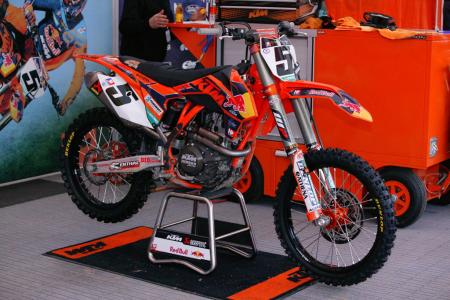Inside the 2013 Supercross Works Bikes

The start of a new Supercross season brings with it a lot of anticipation over and above race results. Its the first time fans, riders and team personnel get to see what the competition has brought to off-road racings largest stage.
The recession has no doubt slowed some of the progress, however, that hasnt stopped much in this sport. During the last few years we have seen tremendous advances in ignition systems, electronic fuel injection, front suspension, and now, for 2013, shock technology.
KTM is the first to introduce an air shock to modern racing. The idea is not new in principle, but it does break a longstanding tradition of externally sprung components. The new WP air shock is enshrouded in mystery that has suspension technicians intrigued.
Like most air shocks, the external coil spring is absent, as on Dungeys KTM 450SX. We dont know for sure if there is any type of internal spring, although suspension experts believe there may be one to control top out.
Dungeys shock has a braided line that leads from the shock body to the airbox, and its not known if this contains data-acquisition components, some type of smart or active technology, or perhaps air lines to another hidden area. One of the challenges with air shocks is controlling heat, and thusly, air pressure and, and this line may be associated with ameliorating this issue.
There are traditionally two different types of air shocks and each has its own set of advantages and disadvantages. The first is the air bag or bladder-style air shock, and these can use one or two separate air chambers to control force. The second style is the telescoping cylinders like the original Fox Air Shox, but the disadvantage here is seal drag, which is one of the challenges of the new wave of air forks now being used on production motocross bikes.
We spoke to Race Techs Paul Thede who says no one will know what type of technology WP and KTM are employing until they want to let the secret out of the bag. There are too many variables that come into play, but Thede does believe damping would be along the lines of traditional style with oil running through small orifices such as valves and shims.
Another trend seen in the pits is the conversion to Showa suspension by everyone except KTM and privateer Josh Hansen. Hansens Kawasaki is one of the last bikes to use Kayaba components.
We got terrific access into the Anaheim 1 pits and snapped a ton of photos that reveal many key details of the exotic supercross machinery, so scroll down to see what we discovered.
Related Reading
2013 AMA Supercross Anaheim 1 Race Report
AMA Supercross Stars Autograph Signing Ahead of 2013 Season Opener in Anaheim
Red Bull KTM 2013 AMA Supercross and Motocross Photo Shoot with Dungey, Roczen and Musquin
Dodger Stadium Renovations Force 2013 AMA Supercross Round to Move to Anaheim
2013 AMA Supercross Schedule Released
2012 AMA Flat Track Season Finale - Video
MotoGP 2012 at Laguna Seca
2011 Red Bull U.S. Grand Prix Event Report - Video

Motorcycle.com presents an unrivaled combination of bike reviews and news written by industry experts
More by Motorcycle.com Staff






















































Comments
Join the conversation